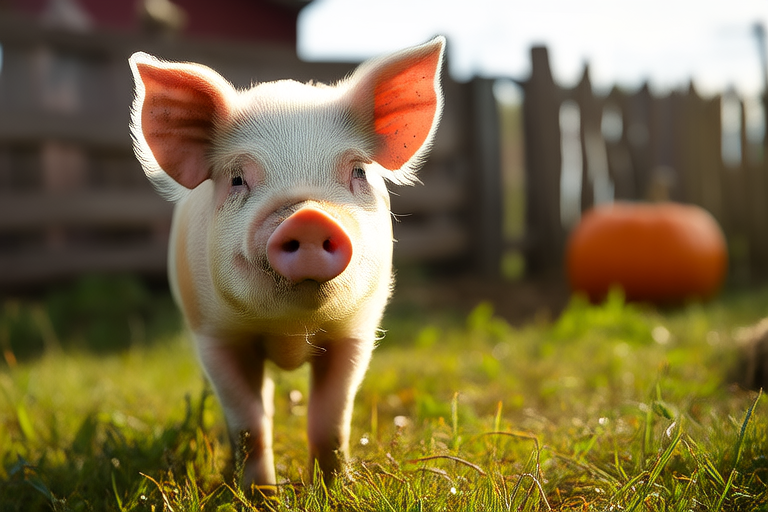From Micro to Macro: Unveiling the World of Mini Pigs
Welcome to the fascinating world of mini pigs, a unique and increasingly popular choice for pet lovers. These pint-sized porcines offer a delightful blend of intelligence, affection, and charm that has captured the hearts of many. In this comprehensive guide, we will explore the various aspects of mini pigs, from their size variations to their care requirements, helping you understand why they make such wonderful companions.
Mini Pigs as Unique Pets
Mini pigs, or teacup pigs as they are sometimes called, have become a favorite among pet owners due to their small size and manageable lifestyle. Unlike their larger counterparts, these diminutive creatures are ideal for apartment living and can easily adapt to urban environments. Their intelligence and playful nature make them excellent companions, offering a unique bond that goes beyond the typical pet experience.
Variations in Size from Micro to Macro
One of the most intriguing aspects of mini pigs is their remarkable variation in size. From the micro-mini pig, which typically weighs around 30 pounds or less, to the larger breeds that may reach up to 150 pounds, there is a wide spectrum of sizes within the mini pig category. This diversity allows potential owners to choose a pig that best fits their living space and lifestyle.
The term ‘micro’ often refers to pigs that weigh between 20 to 60 pounds fully grown, while ‘teacup’ typically indicates a smaller size range within the micro category. However, it’s important to note that there is no official standard for these terms, and they can vary widely depending on the breeder and individual genetics.
Temperament and Care Requirements
Mini pigs are known for their friendly and social nature, making them great pets for families and individuals alike. They are highly intelligent animals capable of learning tricks and responding to commands, much like dogs. Despite their small size, they require a balanced diet rich in nutrients to maintain their health and energy levels. A diet high in fiber and low in sugar is recommended, supplemented with fresh fruits and vegetables.
Regular exercise is also crucial for maintaining their physical and mental well-being. Providing toys and activities that stimulate their minds helps prevent boredom and destructive behavior. Additionally, regular veterinary check-ups are essential to ensure they receive proper vaccinations and preventive treatments.
Popular Breeds Suitable as Pets
Several breeds of mini pigs are particularly well-suited for domestic life. The Juliana pig, known for its gentle demeanor and striking appearance, is a popular choice among pet owners. Other notable breeds include the Vietnamese pot-bellied pig, famous for its compact size and docile nature, and the KuneKune, recognized for its sweet disposition and distinctive features.
Each breed comes with its own set of characteristics, so it’s important to research and select one that aligns with your lifestyle and preferences. Breeders can provide valuable information about the specific needs and behaviors of different breeds, helping you make an informed decision.
Addressing Misconceptions About Size and Lifespan
One of the most common misconceptions about mini pigs is their size. Many people assume that all mini pigs remain small throughout their lives, but this is far from true. Proper nutrition and genetics play significant roles in determining a pig’s final size. Some pigs may grow larger than expected if not fed a carefully controlled diet.
Another misconception is regarding their lifespan. While mini pigs can live up to 15 years or more, this varies based on factors such as diet, exercise, and overall care. Ensuring they lead healthy lives extends their longevity, making them long-term companions.
Tips for Potential Owners
Before bringing a mini pig into your home, there are several important considerations to keep in mind:
- Research extensively: Understand the responsibilities involved in caring for a mini pig, including dietary needs, exercise requirements, and behavioral training.
- Choose a reputable breeder: Select a breeder who prioritizes the health and welfare of their pigs, providing proper documentation and support.
- Create a safe environment: Ensure your home is secure and free from hazards that could harm your new pet. Pigs are curious and may investigate anything within reach.
- Prepare for the long haul: Mini pigs can live for over a decade, so be prepared for a lifelong commitment.
Growing Trend of Mini Pigs as Companions
The popularity of mini pigs as pets continues to rise, driven by their unique personalities and adaptability. As more people discover the joys of owning a mini pig, the demand for these charming creatures is likely to increase. With proper education and awareness, the trend of mini pigs as beloved companions will continue to flourish.
In conclusion, mini pigs offer a unique and rewarding pet experience for those willing to commit to their care. By understanding their size variations, temperament, and specific needs, potential owners can provide the love and attention necessary for these intelligent and affectionate animals. Whether you’re a seasoned pet owner or considering adding a mini pig to your family for the first time, there’s no denying the special bond that develops between humans and these remarkable creatures.
